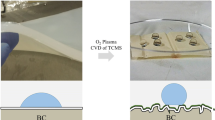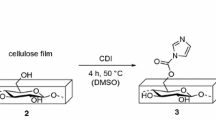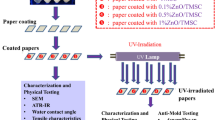Abstract
The microbial infection as a result of biofilm formation is a serious problem in various fields of application in the paper industry including fouling of filters in air conditioning systems, wallpaper, medical and food packaging as well as ancient documents. In this study, we document a highly nonfouling surface coating formed by a functional copolymer consisting of 2-methacryloyloxyethyl phosphorylcholine, as a zwitterionic and cell repellent component, and 4-benzophenyl methacrylate, acting as an anchor group for a fast UV-induced persistent covalent attachment on thin cellulose model films deposited on silicon wafers. The grafting process, studied by UV–Vis spectroscopy, is much faster in comparison with common grafting-to techniques. The obtained sustainable and nonleaching surface coatings were analyzed by attenuated total reflectance-Fourier transform infrared spectroscopy, contact angle measurements, spectroscopic in situ ellipsometry, and atomic force microscopy. Incubation of the modified cellulose surfaces with either Escherichia coli, Bacillus subtilis or Saccharomyces cerevisiae demonstrates that the zwitterionic polymer functionalization has substantial nonfouling capacity against both Gram-negative and Gram-positive bacteria as well as the yeast fungus.





Similar content being viewed by others
References
Kenawy, E-R, Worley, SD, Broughton, R, “The Chemistry and Applications of Antimicrobial Polymers: A State-of-the-Art Review.” Biomacromolecules, 8 (5) 1359–1384 (2007)
Tuson, HH, Weibel, DB, “Bacteria-Surface Interactions.” Soft Matter, 9 (17) 4368–4380 (2013)
Dexter, SC, Sullivan, JD, Williams, J, Watson, SW, “Influence of Substrate Wettability on the Attachment of Marine Bacteria to Various Surfaces.” Appl. Microbiol., 30 (2) 298–308 (1975)
Thallinger, B, Prasetyo, EN, Nyanhongo, GS, Guebitz, GM, “Antimicrobial Enzymes: An Emerging Strategy to Fight Microbes and Microbial Biofilms.” Biotechnol. J., 8 (1) 97–109 (2013)
Conte, A, Buonocore, GG, Bevilacqua, A, Sinigaglia, M, Del Nobile, MA, “Immobilization of Lysozyme on Polyvinylalcohol Films for Active Packaging Applications.” J. Food Prot., 69 (4) 866–870 (2006)
Li, X, Xing, Y, Jiang, Y, Ding, Y, Li, W, “Antimicrobial Activities of ZnO Powder-Coated PVC Film to Inactivate Food Pathogens.” Int. J. Food Sci. Technol., 44 (11) 2161–2168 (2009)
De Lancey Pulcini, E, “Bacterial Biofilms: A Review of Current Research.” Nephrologie, 22 (8) 439–441 (2001)
Jyotsna, C, Guangyin, Z, Mahmoud, AG, “Fungal Biofilms and Antimycotics.” Current Drug Targets, 6 (8) 887–894 (2005)
Gour, N, Ngo, KX, Vebert-Nardin, C, “Anti-Infectious Surfaces Achieved by Polymer Modification.” Macromol. Materi. Eng., 299 (6) 648–668 (2014)
Monroe, D, “Looking for Chinks in the Armor of Bacterial Biofilms.” PLOS Biol., 5 (11) e307 (2007)
Siedenbiedel, F, Tiller, JC, “Antimicrobial Polymers in Solution and on Surfaces: Overview and Functional Principles.” Polymers, 4 (1) 46 (2012)
Tiller, JC, Liao, C-J, Lewis, K, Klibanov, AM, “Designing Surfaces that Kill Bacteria on Contact.” Proc. Natl. Acad. Sci., 98 (11) 5981–5985 (2001)
Aumsuwan, N, McConnell, MS, Urban, MW, “Tunable Antimicrobial Polypropylene Surfaces: Simultaneous Attachment of Penicillin (Gram +) and Gentamicin (Gram −).” Biomacromolecules, 10 (3) 623–629 (2009)
Schwartz, VB, Thétiot, F, Ritz, S, Pütz, S, Choritz, L, Lappas, A, Förch, R, Landfester, K, Jonas, U, “Antibacterial Surface Coatings from Zinc Oxide Nanoparticles Embedded in Poly(N-isopropylacrylamide) Hydrogel Surface Layers.” Adv. Funct. Mater., 22 (11) 2376–2386 (2012)
Banerjee, I, Pangule, RC, Kane, RS, “Antifouling Coatings: Recent Developments in the Design of Surfaces That Prevent Fouling by Proteins, Bacteria, and Marine Organisms.” Adv. Mater., 23 (6) 690–718 (2011)
Khalil, F, Franzmann, E, Ramcke, J, Dakischew, O, Lips, KS, Reinhardt, A, Heisig, P, Maison, W, “Biomimetic PEG-Catecholates for Stabile Antifouling Coatings on Metal Surfaces: Applications on TiO2 and Stainless Steel.” Colloids Surf. B Biointerfaces, 117 (Supplement C) 185–192 (2014)
Zeng, R, Luo, Z, Zhou, D, Cao, F, Wang, Y, “A Novel PEG Coating Immobilized onto Capillary Through Polydopamine Coating for Separation of Proteins in CE.” Electrophoresis, 31 (19) 3334–3341 (2010)
Chae, KH, Jang, YM, Kim, YH, Sohn, O-J, Rhee, JI, “Anti-Fouling Epoxy Coatings for Optical Biosensor Application Based on Phosphorylcholine.” Sens. Actuators B Chem., 124 (1) 153–160 (2007)
Akkahat, P, Kiatkamjornwong, S, Yusa, S-I, Hoven, VP, Iwasaki, Y, “Development of a Novel Antifouling Platform for Biosensing Probe Immobilization from Methacryloyloxyethyl Phosphorylcholine-Containing Copolymer Brushes.” Langmuir, 28 (13) 5872–5881 (2012)
Konradi, R, Acikgoz, C, Textor, M, “Polyoxazolines for Nonfouling Surface Coatings—A Direct Comparison to the Gold Standard PEG.” Macromol. Rapid Commun., 33 (19) 1663–1676 (2012)
Bai, L, Tan, L, Chen, L, Liu, S, Wang, Y, “Preparation and Characterizations of Poly(2-Methyl-2-Oxazoline) Based Antifouling Coating by Thermally Induced Immobilization.” J. Mater. Chem. B, 2 (44) 7785–7794 (2014)
Kobayashi, M, Terayama, Y, Yamaguchi, H, Terada, M, Murakami, D, Ishihara, K, Takahara, A, “Wettability and Antifouling Behavior on the Surfaces of Superhydrophilic Polymer Brushes.” Langmuir, 28 (18) 7212–7222 (2012)
Vogler, EA, Morra, A, Water in Biomaterials Surface Science. Wiley, New York (2001)
Zhu, L-J, Zhu, L-P, Jiang, J-H, Yi, Z, Zhao, Y-F, Zhu, B-K, Xu, Y-Y, “Hydrophilic and Anti-Fouling Polyethersulfone Ultrafiltration Membranes with Poly(2-Hydroxyethyl Methacrylate) Grafted Silica Nanoparticles as Additive.” J. Membr. Sci., 451 (Supplement C) 157–168 (2014)
Sun, Z, Chen, F, “Hydrophilicity and Antifouling Property of Membrane Materials from Cellulose Acetate/Polyethersulfone in DMAc.” Int. J. Biolog. Macromol., 91 (Supplement C) 143–150 (2016)
Shirtcliffe, NJ, Roach, P, “Superhydrophobicity for Antifouling Microfluidic Surfaces.” In: Jenkins, G, Mansfield, CD (eds.) Microfluidic Diagnostics: Methods and Protocols, pp. 269–281. Humana Press, Totowa, NJ (2013)
Chapman, J, Regan, F, “Nanofunctionalized Superhydrophobic Antifouling Coatings for Environmental Sensor Applications—Advancing Deployment with Answers from Nature.” Adv. Eng. Mater., 14 (4) B175–B184 (2012)
Blossey, R, “Self-cleaning Surfaces—Virtual Realities.” Nat. Mater., 2 (5) 301–306 (2003)
Baier, RE, “The Role of Surface Energy in Thrombogenesis.” Bull. N. Y. Acad. Med., 48 (2) 257–272 (1972)
Minko, S, “Grafting on Solid Surfaces: “Grafting to” and “Grafting from” Methods.” In: Stamm, M (ed.) Polymer Surfaces and Interfaces: Characterization, Modification and Applications, pp. 215–234. Springer, Berlin (2008)
Burkert, S, Bittrich, E, Kuntzsch, M, Müller, M, Eichhorn, K-J, Bellmann, C, Uhlmann, P, Stamm, M, “Protein Resistance of PNIPAAm Brushes: Application to Switchable Protein Adsorption.” Langmuir, 26 (3) 1786–1795 (2010)
Uhlmann, P, Houbenov, N, Brenner, N, Grundke, K, Burkert, S, Stamm, M, “In-Situ Investigation of the Adsorption of Globular Model Proteins on Stimuli-Responsive Binary Polyelectrolyte Brushes.” Langmuir, 23 (1) 57–64 (2007)
Barbey, R, Lavanant, L, Paripovic, D, Schüwer, N, Sugnaux, C, Tugulu, S, Klok, H-A, “Polymer Brushes via Surface-Initiated Controlled Radical Polymerization: Synthesis, Characterization, Properties, and Applications.” Chem. Rev., 109 (11) 5437–5527 (2009)
Turro, NJ, Modern Molecular Photochemistry. University Science Books, Mill Valley, CA (1991)
Oster, GK, Oster, G, “Photochemical Modifications of High Polymers by Visible Light.” J. Polym. Sci., 48 (150) 321–327 (1960)
Lin, AA, Sastri, VR, Tesoro, G, Reiser, A, Eachus, R, “On the Crosslinking Mechanism of Benzophenone-Containing Polyimides.” Macromolecules, 21 (4) 1165–1169 (1988)
Higuchi, H, Yamashita, T, Horie, K, Mita, I, “Photo-Cross-Linking Reaction of Benzophenone-Containing Polyimide and Its Model Compounds.” Chem. Mater., 3 (1) 188–194 (1991)
Dormán, G, Nakamura, H, Pulsipher, A, Prestwich, GD, “The Life of Pi Star: Exploring the Exciting and Forbidden Worlds of the Benzophenone Photophore.” Chem. Rev., 116 (24) 15284–15398 (2016)
Dhende, VP, Samanta, S, Jones, DM, Hardin, IR, Locklin, J, “One-Step Photochemical Synthesis of Permanent, Nonleaching, Ultrathin Antimicrobial Coatings for Textiles and Plastics.” ACS Appl. Mater. Interfaces, 3 (8) 2830–2837 (2011)
Marazzi, M, Mai, S, Roca-Sanjuán, D, Delcey, MG, Lindh, R, González, L, Monari, A, “Benzophenone Ultrafast Triplet Population: Revisiting the Kinetic Model by Surface-Hopping Dynamics.” J. Phys. Chem. Lett., 7 (4) 622–626 (2016)
Naumann, CA, Prucker, O, Lehmann, T, Rühe, J, Knoll, W, Frank, CW, “The Polymer-Supported Phospholipid Bilayer: Tethering as a New Approach to Substrate–Membrane Stabilization.” Biomacromolecules, 3 (1) 27–35 (2002)
Prucker, O, Naumann, CA, Rühe, J, Knoll, W, Frank, CW, “Photochemical Attachment of Polymer Films to Solid Surfaces via Monolayers of Benzophenone Derivatives.” J. Am. Chem. Soc., 121 (38) 8766–8770 (1999)
Toomey, R, Freidank, D, Rühe, J, “Swelling Behavior of Thin, Surface-Attached Polymer Networks.” Macromolecules, 37 (3) 882–887 (2004)
Shen, WW, Boxer, SG, Knoll, W, Frank, CW, “Polymer-Supported Lipid Bilayers on Benzophenone-Modified Substrates.” Biomacromolecules, 2 (1) 70–79 (2001)
Pahnke, J, Rühe, J, “Attachment of Polymer Films to Aluminium Surfaces by Photochemically Active Monolayers of Phosphonic Acids.” Macromol. Rapid Commun., 25 (15) 1396–1401 (2004)
Leshem, B, Sarfati, G, Novoa, A, Breslav, I, Marks, RS, “Photochemical Attachment of Biomolecules onto Fibre-Optics for Construction of a Chemiluminescent Immunosensor.” Luminescence, 19 (2) 69–77 (2004)
Bunte, C, Rühe, J, “Photochemical Generation of Ferrocene-Based Redox-Polymer Networks.” Macromol. Rapid Commun., 30 (21) 1817–1822 (2009)
Samuel, JDJS, Brenner, T, Prucker, O, Grumann, M, Ducree, J, Zengerle, R, Rühe, J, “Tailormade Microfluidic Devices Through Photochemical Surface Modification.” Macromol. Chem. Phys., 211 (2) 195–203 (2010)
Virkar, A, Ling, M-M, Locklin, J, Bao, Z, “Oligothiophene Based Organic Semiconductors with Cross-Linkable Benzophenone Moieties.” Synth. Met., 158 (21) 958–963 (2008)
Brandstetter, T, Böhmer, S, Prucker, O, Bissé, E, zur Hausen, A, Alt-Mörbe, J, Rühe, J, “A Polymer-Based DNA Biochip Platform for Human Papilloma Virus Genotyping.” J. Virol. Methods, 163 (1) 40–48 (2010)
Bunte, C, Prucker, O, König, T, Rühe, J, “Enzyme Containing Redox Polymer Networks for Biosensors or Biofuel Cells: A Photochemical Approach.” Langmuir, 26 (8) 6019–6027 (2010)
Schaub, M, Wenz, G, Wegner, G, Stein, A, Klemm, D, “Ultrathin Films of Cellulose on Silicon Wafers.” Adv. Mater., 5 (12) 919–922 (1993)
Mohan, T, Kargl, R, Doliška, A, Vesel, A, Köstler, S, Ribitsch, V, Stana-Kleinschek, K, “Wettability and Surface Composition of Partly and Fully Regenerated Cellulose Thin Films from Trimethylsilyl Cellulose.” J. Colloid Interface Sci., 358 (2) 604–610 (2011)
Suchy, M, Linder, MB, Tammelin, T, Campbell, JM, Vuorinen, T, Kontturi, E, “Quantitative Assessment of the Enzymatic Degradation of Amorphous Cellulose by Using a Quartz Crystal Microbalance with Dissipation Monitoring.” Langmuir, 27 (14) 8819–8828 (2011)
Nanjundan, S, Unnithan, CS, Selvamalar, CSJ, Penlidis, A, “Homopolymer of 4-Benzoylphenyl Methacrylate and Its Copolymers with Glycidyl Methacrylate: Synthesis, Characterization, Monomer Reactivity Ratios and Application as Adhesives.” React. Funct. Polym., 62 (1) 11–24 (2005)
Kontturi, E, Thüne, PC, Niemantsverdriet, JW, “Cellulose Model Surfaces Simplified Preparation by Spin Coating and Characterization by X-ray Photoelectron Spectroscopy, Infrared Spectroscopy, and Atomic Force Microscopy.” Langmuir, 19 (14) 5735–5741 (2003)
Karabudak, E, Kas, R, Ogieglo, W, Rafieian, D, Schlautmann, S, Lammertink, RGH, Gardeniers, HJGE, Mul, G, “Disposable Attenuated Total Reflection-Infrared Crystals from Silicon Wafer: A Versatile Approach to Surface Infrared Spectroscopy.” Anal. Chem., 85 (1) 33–38 (2013)
Werner, C, Eichhorn, KJ, Grundke, K, Simon, F, Grählert, W, Jacobasch, HJ, “Insights on Structural Variations of Protein Adsorption Layers on Hydrophobic Fluorohydrocarbon Polymers Gained by Spectroscopic Ellipsometry (Part I).” Colloids Surf. A Physicochem. Eng. Asp., 156 (1) 3–17 (1999)
Kontturi, E, Tammelin, T, Osterberg, M, “Cellulose-Model Films and the Fundamental Approach.” Chem. Soc. Rev., 35 (12) 1287–1304 (2006)
Ilharco, LM, Garcia, AR, da Lopes da Silva, J, Vieira Ferreira, LF, “Infrared Approach to the Study of Adsorption on Cellulose: Influence of Cellulose Crystallinity on the Adsorption of Benzophenone.” Langmuir, 13 (15) 4126–4132 (1997)
Ilharco, LM, Garcia, AR, Lopes da Silva, J, Lemos, MJ, Vieira Ferreira, LF, “Ultraviolet–Visible and Fourier Transform Infrared Diffuse Reflectance Studies of Benzophenone and Fluorenone Adsorbed onto Microcrystalline Cellulose.” Langmuir, 13 (14) 3787–3793 (1997)
Capeletti, LB, de Oliveira, LF, Gonçalves, KDA, de Oliveira, JFA, Saito, Â, Kobarg, J, Santos, JHZD, Cardoso, MB, “Tailored Silica-Antibiotic Nanoparticles: Overcoming Bacterial Resistance with Low Cytotoxicity.” Langmuir, 30 (25) 7456–7464 (2014)
Givens, BE, Xu, Z, Fiegel, J, Grassian, VH, “Bovine Serum Albumin Adsorption on SiO2 and TiO2 Nanoparticle Surfaces at Circumneutral and Acidic pH: A Tale of Two Nano-Bio Surface Interactions.” J. Colloid Interface Sci., 493 334–341 (2017)
Hyltegren, K, Skepö, M, “Adsorption of Polyelectrolyte-Like Proteins to Silica Surfaces and the Impact of pH on the Response to Ionic Strength. A Monte Carlo Simulation and Ellipsometry Study.” J. Colloid Interface Sci., 494 (Supplement C) 266–273 (2017)
Acknowledgments
A. S. Münch gratefully acknowledges the funding from Federal Ministry for Economic Affairs and Energy (BMWi) of Germany (AiF-IGF 18696 BR). The authors thank Mikhail Malanin for collecting the FTIR spectra and Hannes Kettner for the AFM images. Furthermore, Hartmut Komber is acknowledged for the NMR spectra, Christina Harnisch for conducting the GPC measurements, Michele Wölk for the support in laboratory, and Annabell Radisch (GMBU e.V.) for carrying out the cell adhesion experiments and fluorescence measurements. Dr. Jens Schaller (Thüringisches Institut für Textil- und Kunststoff-Forschung e.V. in Rudolstadt, Germany) is gratefully acknowledged for the provision of trimethylsilyl cellulose.
Author information
Authors and Affiliations
Corresponding authors
Rights and permissions
About this article
Cite this article
Münch, A.S., Fritzsche, T., Haufe, H. et al. Fast preparation of biopassive nonfouling coatings on cellulose. J Coat Technol Res 15, 703–712 (2018). https://doi.org/10.1007/s11998-018-0066-3
Published:
Issue Date:
DOI: https://doi.org/10.1007/s11998-018-0066-3




